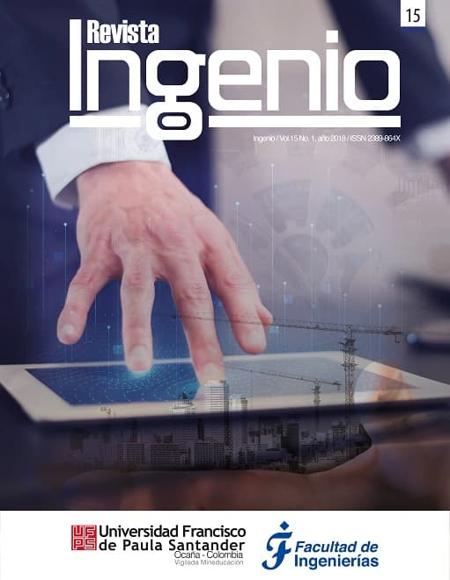Experimental design and analysis to determine the porosity of composite adsorbent materials
Diseño y análisis experimental para determinar la porosidad de materiales adsorbentes compuestos
Main Article Content
Adsorption cooling systems that use residual heat as a source depend on the quality of the adsorbent bed where anhydrous salts are used whose thermal conductivity and porosity are low; for this reason, they are impregnated with materials such as graphite or activated carbon. In this work, experiment design techniques were applied to determine which of the factors involved in the preparation of the adsorbent material generate a significant impact on the porosity of the adsorbent material, for this, surface responses and an optimal region where the material had a porosity were established. high with a minimum cost of production, this has great implication in the simplification of the development of procedures to produce composite adsorbent materials of greater efficiency. It was determined that the materials with a higher percentage of impregnation material improve the porosity conditions.
Downloads
Article Details
E. Pérez, “Diseño y construccion de un sistema de generacion de electricidad a partir del uso de energia solar,” Universidad Francisco de Paula Santander Ocaña, 2014.
C. S. Ioan Sarbu, “General review of solar-powered closed sorption refrigeration systems”,Energy Conversion and Management, vol. 105, p. 403–422, 2015.Doi: https://doi.org/10.1016/j.enconman.2015.07.084
Noriega-Sánchez, C. J., & Pérez-Rojas, E. E. “Sistemas de refrigeración por adsorción como una alternativa para el uso de calor
residual y energía solar”. Revista Ingenio,vol. 4, n° 1, pp. 7-11, 2012. https://doi.org/10.22463/2011642X.1994
AliAl Alilia, Yunho Hwangb, Reinhard Radermacher. “Review of solar thermal air conditioning technologies”. International Journal of Refrigeration, vol. 39, n° 1, pp. 4-42, 2014. Doi: https://doi.org/10.1016/j.ijrefrig.2013.11.028
Fayazmanesh, K. Salari, S. Bahrami, M.“Effective thermal conductivity modeling of consolidated sorption composites containing
graphite flakes.” International Journal of Heatand Mass Transfer. 115(1) 73-79, 2017. Doi:https://doi.org/10.1016/j.ijheatmasstransfer.
07.020
Cheng, F. Wen, R. Huang, Z. Fang, M. Liu, Y. Wu, X. Min, X. “Preparation and analysis of lightweight wall material with expanded graphite (EG)/paraffin composites for solar energy storage”, Applied Thermal Engineering. 120(6), 107-114, 2017. Doi:https://doi.org/10.1016/j.applthermaleng.2017.03.129
R. W. R. O. T. L. J.K. Kiplagat, “Lithium chloride – Expanded graphite composite sorbent for solar powered ice maker”, Solar energy, vol. 84, p. 1587–1594, 2010. Doi: https://doi.org/10.1016/j.solener.2010.06.04
W. R. K. J. W. C. Oliveira RG, “Novel composite sorbent for resorption systems and for chemisorption air conditioners driven by low generation temperature”,Renew Energy, vol. 34, p.2757–2764, 2009. Doi:https://doi.org/10.1016/j.renene.2009.05.016
R. W. G. H. J. Denga, “A review of thermally activated cooling technologies for combined cooling, heating and power systems”, Progress in Energy and Combustion Science, vol. 37(2), p.172–203, 2011. Doi:https://doi.org/10.1016/j.pecs.2010.05.003
W. R. W. C. Oliveira RG, “Evaluation of the cooling performance of a consolidated expanded graphite–calcium chloride reactive bed for chemisorption icemaker”, International Journal of Refrigeration, vol. 30, p. 103–112, 2007. Doi:https://doi.org/10.1016/j.ijrefrig.2006.08.003
R. W. R. O. T. L. M. L. J.K. Kiplagat,“Experimental study on the effects of the operation conditions on the performance of a chemisorption air conditioner powered by low grade heat”, Applied Energy, vol. 1, p.571–580,2013.Doi:https://doi.org/10.1016/j.apenergy.2012.10.025
H. L. K. Han, " Gas permeability of expanded graphite–metallic salt composite", Applied Thermal Engineering, vol. 21(4), p. 453–463,2001.Doi: https://doi.org/10.1016/S1359-4311(00)00056-9




 Perfil Google Scholar
Perfil Google Scholar



